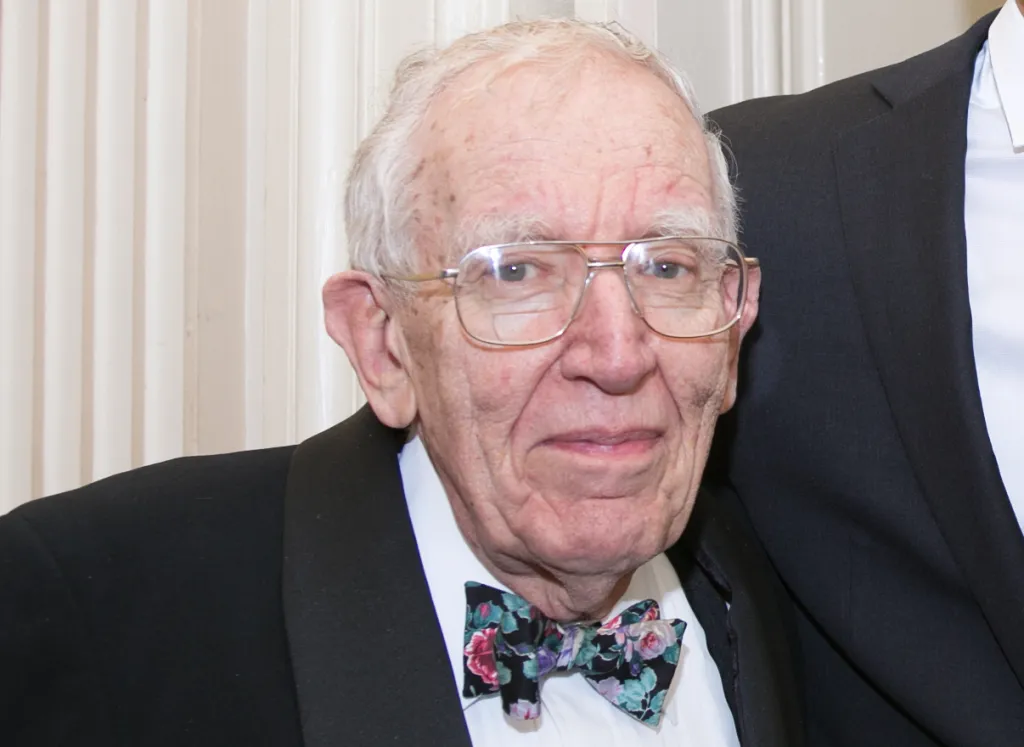
Bruce Sagan, the longtime newspaper publisher who owned the Hyde Park Herald and the Southtown Economist newspapers, and a National Medal of the Arts recipient who worked to bring the Joffrey Ballet from New York to Chicago in 1995, died on Sept. 21 at his Streeterville home. He was 96.
Sagan’s death was confirmed by his son, Paul, who said that his father had died after a brief cancer illness. Sagan previously had lived in the South Loop and prior to that, for several decades in Hyde Park.
Sagan spent seven decades in Chicago journalism — first through his longstanding ownership of the Hyde Park Herald, which began when he was 24 years old in 1953, and then through his 1958 acquisition of the Southtown Economist group of newspapers, which he sold in 1987 after 30 years of ownership. Along the way, Sagan developed a reputation for innovative operations, including offset printing and four-color presses, and building a strong commercial printing operation that also printed the Chicago Defender and the Midwest editions of the New York Times, the Christian Science Monitor and the Investor’s Business Daily.
Born in Summit, New Jersey, in 1929 to Jewish immigrants from what is now western Ukraine, Sagan was the cousin of astronomer Carl Sagan. He studied for a semester at the University of Wisconsin before transferring to the University of Chicago, where he wrote for the student newspaper and then briefly attended law school.
Sagan left law school to pursue journalism full-time, balancing early stints as a copy clerk at Hearst’s International News Service — a job he started in 1951 — and as a night editor at Chicago’s City News Bureau with driving a taxicab and working the late shift on a Campbell Soup Co. factory assembly line.
In 1953, Sagan purchased the Hyde Park Herald, which was Chicago’s oldest community newspaper, as it teetered on the brink of closure. Sagan soon revitalized it, focusing on timely and controversial issues like restrictive housing covenants, racial segregation and urban renewal.
Former aldermanic candidate Gabriel Piemonte, who was editor of the Hyde Park Herald for eight years and a reporter before that, called Sagan “a great guy to work for.”
“Whenever he came into the office, he was always interested in what was happening just with the paper but the news of the time in Hyde Park,” Piemonte said. “He never lost that real affection for (Hyde Park). And he kept his humanity — he was very successful, but he never lost that humanity.”
Bill Gerstein, who formerly owned Mr. G’s Finer Foods in Hyde Park and later was an educator, recalled that Sagan “hired really good writers,” and made the Hyde Park Herald both a source of information and a force for change.
“He ran it as this neighborhood newspaper that everybody in Hyde Park had to read to know what was going on, but he also had an editorial vision for what he wanted it to be about,” Gerstein said. “He would fight against certain things, and at times he would fight against the university and at other times, he would agree with them. He pushed for things and he would argue for things.”
Dan Haley, the cofounder and retired publisher and president of the Wednesday Journal of Oak Park, called Sagan “one of the finest people I’ve ever known.”
“He was so smart, so strategic, so kind and such a good listener,” Haley said. “(It’s a) gigantic loss to our challenged, fragile news system in Chicago.”
Political strategist David Axelrod got his start at the Hyde Park Herald as a political columnist while he was in college. He called Sagan “a remarkable man.”
“He was a great publisher and newsman, with a keen eye on the future,” Axelrod said. “And a great citizen, who cared deeply about our city, state and country.”
Seldom seen without his trademark cardigan and a bow tie, Sagan also was an outspoken advocate of the Hyde Park and Kenwood neighborhoods. In 1963, he and Muriel Beadle, whose husband, George, then was the U. of C.’s president, promoted an urban renewal plan for commercial buildings on urban renewal clearance sites on Harper Avenue between 52nd and 53rd Streets. As part of that urban renewal effort, Sagan and his then-wife Judith in 1964 reopened the old Harper Theatre in Hyde Park’s Harper Court area first for off-Loop professional theater and then for dance; it later became a movie house.
Sagan added the Southtown Economist’s string of South Side community newspapers to his newspaper portfolio in 1958. By 1964, his Southtown Economist chain had seven community newspaper titles on the South Side and in the south suburbs, and it acquired another seven weekly West Side newspapers published by Community Publications, Inc. later that year. From there, he expanded his operations westward, buying weekly newspapers in San Diego and Omaha, Nebraska.
In 1978, Sagan made the Southtown Economist a six-day-a-week newspaper, the Daily Southtown Economist. In 1986, he announced that he had reached an agreement to sell the Southtown Economist group — by this point, 30 titles in all — to St. Louis-based Pulitzer Publishing. Sagan continued working for Pulitzer, heading a unit formed to run his group.
Sagan stepped down as president of Pulitzer Community Newspapers in 1988. He continued to oversee the Hyde Park Herald, and in 1999, he founded a small free weekly newspaper in Bronzeville called the Lakefront Outlook.
Sagan later was one of the investors in Wrapports, a holding company that bought the Chicago Sun-Times and its suburban papers. He was named Wrapports’ chairman in 2016.
Sagan’s association with the Sun-Times ended in 2017, when Wrapports sold the paper to a different consortium led by former Ald. Edwin Eisendrath. Today, the Sun-Times is part of Chicago Public Media.
Sagan retired as the Hyde Park Herald’s publisher in 2018, and merged the paper with the nonprofit South Side Weekly in 2022 in a pairing that Sagan helped to facilitate and hoped would be able to continue supporting community journalism.
“The Hyde Park Herald, standing on its own, like all newspapers, was losing revenue and losing circulation — circumstances we’re all now used to,” Sagan told the South Side Weekly in 2022. “The existence of South Side Weekly and the Herald, in terms of their contents, approaches to an area which is in some ways similar and in some ways overlapping — that offers an opportunity now to be taken that could lead to some understanding of a new economic structure for this kind of journalism.”
Outside of newspaper publishing, Sagan held many other roles. He was the public interest director of the Federal Home Loan Bank of Chicago from 1963 until 1970, and he chaired the Illinois Housing Development Authority from 1973 until 1977, during a time when the authority built thousands of moderate-income housing units amid federal retrenchment. The group also helped draft early Section 8 housing legislation and pioneered mixed-income projects.
Sagan also cofounded the Hyde Park Federal Savings and Loan to fight redlining, and he served on the Chicago Library Board from 1979 until 1980. He was a member of the Chicago Housing Authority’s board from 1987 until 1988, and in the 1990s, he chaired then-Cook County Assessor Thomas Hynes’ Assessor’s Committee on Assessment Equity.
“He had strong feelings about justice, equity and democracy. He grew up with it, honed it at the U. of C. and kept working at what he loved and believed made for a strong, vibrant community,” Paul Sagan said. “That meant founding strong civic organizations, from building affordable housing to cultural institutions.”
Sagan also was a visible and enthusiastic devotee of the arts. In the 1960s, he served on the Illinois Arts Council’s dance advisory panel, and in 1969, he was named to the group’s board. He then was appointed the council’s chairman in 1974, serving until 1977. And in 1983, Sagan joined the board of the Steppenwolf Theatre Company and later chaired its board. Sagan also was named in 1990 to the board of the Chicago Educational Television Association’s Radio Committee — the panel overseeing WFMT-FM — and served in that role for more than two decades.
Sagan — described in the 1996 by the Tribune’s Richard Christiansen as a “sandy-haired, gum-chewing, outwardly casual maestro of arts entrepreneurs” — was responsible in large part for raising the $8.2 million needed to help fund a new 515-seat theater for Steppenwolf in 1991. Sagan marshaled private, corporate and state funding to make the new theater a reality.
“He loved live performing arts,” Sagan’s son said. “He loved hanging out with the artists and they loved him back.”
Sagan was the key middleman in bringing the then-financially struggling Joffrey Ballet from New York to Chicago in 1995. Though he was unable to merge the Joffrey with Ballet Chicago as he had attempted, Sagan remained steadfast that the Joffrey nonetheless belonged in Chicago. He eventually served as vice president and then president of the Joffrey’s board.
“Artists are forever taking risks and finding ways of getting around difficulties. They adapt. You should be able to do that in the business end of the arts too,” Sagan told the Tribune in 1996. “If one plan doesn’t work, create another one. If one road is shut, find another one. No matter what the detours, find a way to get to your goal.”
With his second wife, Bette Cerf Hill, Sagan helped to create the Printers Row Lit Fest in 1985.
President Joe Biden awarded Sagan the National Medal of the Arts in a ceremony at the White House in 2024.
A marriage to Judith Sagan ended in divorce. In addition to his son and Hill, Sagan is survived by another son, Alex; three stepdaughters, Catherine Hill, Theresa Neptune and Diana Lourenco Hill; 12 grandchildren and nine great-grandchildren.
Sagan’s family has not announced plans for a funeral.
Bob Goldsborough is a freelance reporter.



